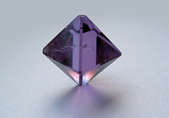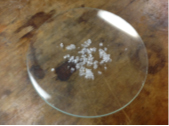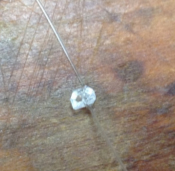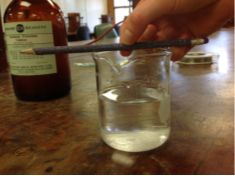Alum, or potassium aluminium sulfate, is a chemical compound with the formula KAl(SO4).12H2O. It has been known for thousands of years and is used in various ways - in taxidermy, as a deodorant, in pickling food, in fire extinguishers. Probably its most important use is in the purification of drinking water.
It forms beautiful, regular octahedral crystals such as the one shown here. Normally alum crystals are colourless, but if the 'normal' alum (KAl(SO4).12H2O) is mixed with 'chrome alum' (KCr(SO4).12H2O) then the crystals will have a purple colour. The samples you will be sent if you enter the competition will allow you to grow these purple crystals.
To grow large single crystals of alum, you first need to grow what is called a seed crystal. This should be a single crystal, but just a small one. (It is normally better for the Alum to crystallise as lots of small crystals rather than one big one). A suitable seed crystal is then suspended in a supersaturated solution of alum. A supersaturated solution is one which has more alum dissolved that is normally possible. Such a solution wants to get rid of the extra dissolved solid – if you are careful then it will do this by adding solid alum to your seed crystal, making it grow bigger.
Step 1:

Make a supersaturated solution of alum. Do this by adding alum to hot water until no more will dissolve.
The exact amount of alum will vary depending on the temperature of the water but it will be about 15 g/25 mL.
Step 2:

Pour some of the solution into a shallow evaporating dish and leave in a cool, dark, undisturbed cupboard overnight. As the solution cools and begins to evaporate, small seed crystals will form in the evaporating dish.
Step 3:

Select your seed crystal. Find the nicest one by looking at them with a magnifying glass – it should be a single crystal (not two or more stuck together) and transparent, with sharp edges and corners. Carefully remove your seed crystal using tweezers (try not to touch the crystal with your fingers) and the tie it to a length of fine nylon fishing line, tying a knot around the seed crystal. Then tie the other end of the fishing line around a pencil or similar.
Step 4:
Make another supersaturated solution of alum in a clean beaker or jar. Suspend the seed crystal in the saturated solution Make sure it is not touching the sides or the bottom of the container. Cover with aluminium foil or filter paper and leave in an undisturbed place. It is vital that you minimise how much you move the crystal. It is also important that the temperature remains as constant as possible – you could place the beaker in a chilly bin or similar to help with this. If the solution heats up (because the heaters in your classroom turn on unexpectedly) then your crystal may redissolve!
Step 5:

Check on the crystal each day. There should be visible growth of the crystal. If the crystal stops growing or decreases in size, the solution is no longer saturated so a new one will need to be made. To do this first carefully remove your crystal, then warm the solution and dissolve some more alum in it. Then, when it has cooled back to room temperature, return the crystal to the solution. You may have to do this more than once, until you run out of Alum (remember that you can only use one bag (100 g) per crystal).
Step 6:
When the crystal has grown as large as it can, then carefully remove it, let it dry on some paper towel. If you want to send it away for judging, then you will need to think of a way that can be sent without it breaking. A glass sample container was included in your package with your Alum so you could use this if you crystal will fit in it (you will need to think about how to stop it rattling around). If it is too big for this you could maybe send it in a Kinder Surprise egg?
Watch a video about growing crystals.
GOOD LUCK!!
